E-commerce has transformed how we buy and sell, offering unparalleled convenience and access to a global market. For both businesses and customers, e-commerce presents numerous advantages. Here’s a guide on leveraging e-commerce to maximize growth and convenience.
Reach a Global Audience
-
Expand Beyond Local Markets:
E-commerce removes geographical limitations, allowing you to reach customers across the globe. This means your business can scale quickly without requiring physical storefronts in multiple locations.
-
24/7 Access for Customers:
Unlike brick-and-mortar stores, e-commerce platforms operate round-the-clock, enabling customers to browse and shop at their convenience. This accessibility can greatly increase sales potential.
Lower Operational Costs
-
Save on Overhead Costs:
E-commerce reduces expenses related to rent, utilities, and in-store staffing. Online shopping stores generally require less infrastructure, making it easier for small businesses and startups to enter the market.
-
Efficient Inventory Management:
Digital tools like inventory tracking software help monitor stock levels in real-time, reducing waste and ensuring timely restocks.
Utilize Digital Marketing for Targeted Reach
-
Use Social Media and SEO:
Platforms like Facebook, Instagram, and Google allow you to target customers based on interests, location, and demographics, making your marketing more efficient and cost-effective.
-
Leverage Data for Personalized Marketing:
E-commerce platforms collect data on customer preferences and behavior, which you can use to create personalized promotions and product recommendations, enhancing customer engagement.
Enhance Customer Experience with Technology
-
Provide Detailed Product Information:
With an online store, you can offer product descriptions, images, reviews, and even videos. This helps customers make informed decisions and builds trust in your brand.
-
Offer Convenient Payment and Shipping Options:
Various payment gateways and flexible shipping options make the buying experience smoother, encouraging customers to complete purchases.
Analyze and Optimize Using Customer Insights
-
Track Customer Behavior:
Use analytics tools like Google Analytics to monitor customer behavior on your website. Insights from these tools can help you optimize product listings, improve site navigation, and enhance overall user experience.
-
Respond to Feedback for Continuous Improvement:
Customer feedback, including reviews and surveys, offers valuable insights. Use this feedback to improve product offerings, adjust pricing, and refine your e-commerce strategy.
Take Advantage of Mobile Shopping Trends
-
Optimize Your Website for Mobile Users:
With the rise in mobile shopping, ensure your website is mobile-friendly. This includes responsive design, quick load times, and simple navigation to provide a seamless experience.
-
Consider Developing a Mobile App:
A dedicated app can boost engagement and make it easier for loyal customers to shop regularly. Apps also provide additional marketing channels through notifications and personalized offers.
Conclusion
E-commerce offers a powerful platform for businesses to grow, reach new markets, and optimize operations. By understanding and leveraging the advantages of e-commerce, such as global reach, cost efficiency, customer data insights, and mobile shopping trends, businesses can build a competitive edge. A focus on delivering an exceptional online experience—through clear product information, convenient payment options, and responsive customer service—helps turn visitors into loyal customers. For those ready to harness e-commerce’s potential, the opportunities are vast, promising sustainable growth and a robust online presence.
FAQs:
What are the primary advantages of using e-commerce for a business?
E-commerce offers a global reach, 24/7 availability, reduced operating costs, and valuable data insights into customer preferences. It enables businesses to efficiently market to specific audiences and streamline operations.
How can small businesses take advantage of e-commerce?
Small businesses benefit from lower overhead costs, wider customer reach, and flexible growth without needing a physical store. E-commerce allows them to quickly scale, target specific demographics, and manage inventory more effectively.
How can I drive more traffic to my e-commerce site?
To increase traffic, optimize for SEO, run social media campaigns, and offer engaging content like blog posts or video demos. Paid ads, influencer partnerships, and customer reviews can also attract more visitors.
What technology tools are essential for e-commerce success?
Key tools include a secure website or mobile app, analytics platforms (e.g., Google Analytics), inventory and customer relationship management (CRM) software, and a user-friendly payment gateway. Mobile optimization is essential for improving user experience on all devices.
How can e-commerce help me understand my customers better?
E-commerce provides data on customer behavior, such as their shopping habits, product preferences, and feedback. Analytics tools enable businesses to use this data for personalized marketing, optimizing products, and enhancing customer satisfaction.
How do I improve the customer experience on my e-commerce platform?
Create a seamless user experience by making your site fast, easy to navigate, and mobile-friendly. Offer clear product descriptions, quality images, multiple payment options, and excellent customer support. Also, maintain transparent policies on returns and shipping.
Is it possible to run an e-commerce business without a physical location?
Yes, many e-commerce businesses operate solely online, saving costs associated with physical storefronts. This model focuses on efficient digital operations, customer engagement, and targeted online marketing.
Why is mobile optimization important for e-commerce?
With many consumers shopping from their phones, mobile optimization ensures a smooth experience on any device. This improves customer satisfaction and can increase conversion rates, as mobile users can easily browse and purchase products.
How can I create effective product listings for my e-commerce store?
Use high-quality images, detailed descriptions, and SEO-friendly keywords. Highlight key features and include customer reviews. Providing clear specifications and a “Frequently Bought Together” section can help boost sales.
What are some common pitfalls to avoid in e-commerce?
Avoid slow-loading websites, poor-quality images, and complicated navigation. Ensure a streamlined checkout process, mobile compatibility, and a well-structured SEO plan. Neglecting customer feedback and having unclear return policies can also harm user trust and retention.




Pingback: 11.11 Biggest Sale of the Year is Live on CyberMart.pk! - Blog By CyberMart.PK